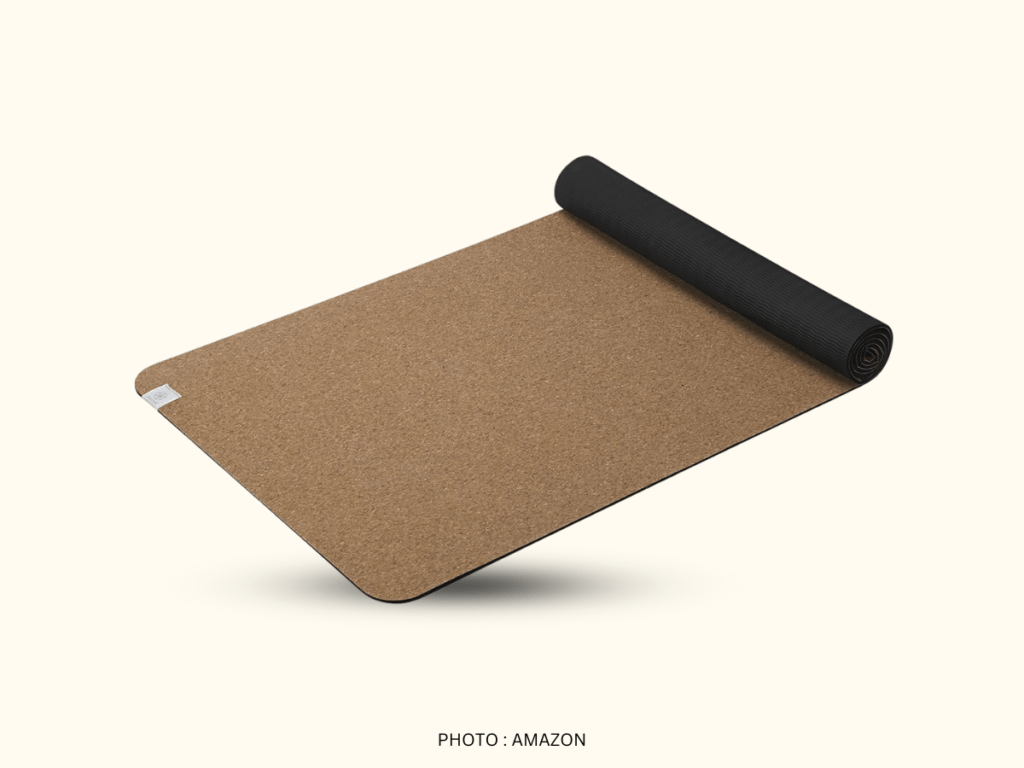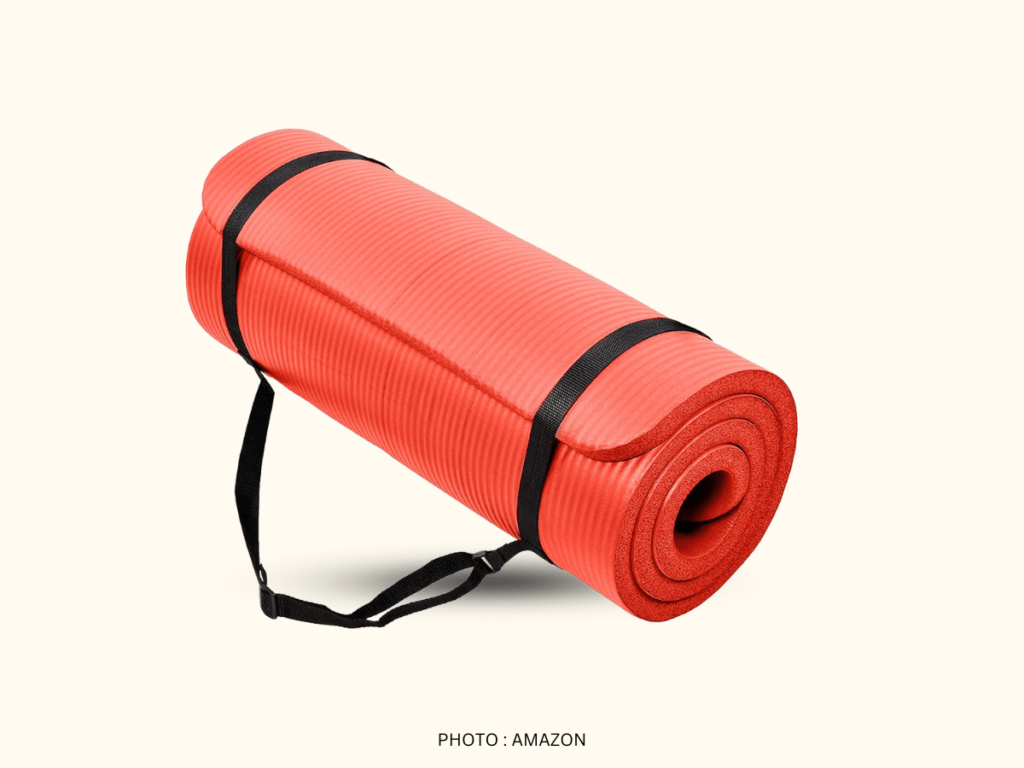
Choosing the right yoga mat is key for beginners. Eco-friendly mats are now popular due to their sustainability. They’re made from natural materials like natural rubber, which is safe for your skin and the planet.
We’ll help you pick the best eco-friendly yoga mats. You’ll learn about the benefits of sustainable and eco-friendly mats.
A serene and harmonious scene depicting a selection of five eco-friendly yoga mats arranged on a natural wooden floor, with a clean, minimalist backdrop. The mats are crafted from sustainable materials such as natural rubber, cork, or recycled plastic, reflecting the latest trends in sustainable fitness gear. Soft, diffused lighting bathes the scene, creating a calming and inviting atmosphere. The mats are positioned in a visually appealing arrangement, showcasing their unique designs and textures. The overall composition conveys a sense of wellness, simplicity, and environmental consciousness, perfectly suited for the “Top 5 Best Eco-Friendly Yoga Mats for Beginners in 2025” section of the article.
Switching to eco-friendly mats is great for the environment, whether you’re new or experienced. The market offers many options, making it hard to choose. Our guide aims to help you find the perfect mat for your practice.
Best Yoga Mats for Every Practice: A Comprehensive Review
Yoga mats are an essential part of any yoga practice, providing comfort, stability, and support during workouts. Whether you’re a beginner or an experienced yogi, choosing the right yoga mat can make a big difference. In this review, we’ll explore the top-rated yoga mats available on Amazon to help you find the perfect one for your needs.
1. Manduka PRO Yoga Mat

Rating: ⭐⭐⭐⭐⭐ (4.7/5)
Best for: Advanced yogis & professionals
The Manduka PRO Yoga Mat is a premium choice designed for serious yoga practitioners. With a high-density cushion, joint protection, and excellent durability, this mat is ideal for those who practice regularly.
✅ Pros:
✔️ Extra cushioning for joint support
✔️ High durability – lasts for years
✔️ Non-toxic, eco-friendly materials
❌ Cons:
❌ Slightly heavier than standard mats
❌ Requires a break-in period for maximum grip
2. Liforme Yoga Mat

Rating: ⭐⭐⭐⭐⭐ (4.8/5)
Best for: Alignment & grip
The Liforme Yoga Mat is famous for its alignment guide system, which helps improve posture and form. The mat features a non-slip surface that provides excellent grip, even during sweaty sessions.
✅ Pros:
✔️ Superior grip with sweat-absorbing technology
✔️ Eco-friendly and biodegradable
✔️ Alignment lines for perfect posture
❌ Cons:
❌ Slightly expensive
❌ Requires gentle cleaning to maintain quality
3. Gaiam Essentials Thick Yoga Mat

Rating: ⭐⭐⭐⭐ (4.5/5)
Best for: Beginners & budget-conscious buyers
The Gaiam Essentials Thick Yoga Mat is a fantastic choice for beginners. It’s extra thick (6mm) to provide comfort for knees and joints, making it a great option for restorative or gentle yoga.
✅ Pros:
✔️ Affordable price
✔️ Extra cushioning for comfort
✔️ Comes with a carrying strap
❌ Cons:
❌ Not ideal for intense workouts due to lower grip
❌ Can wear down faster with frequent use
4. BalanceFrom GoYoga Mat

Rating: ⭐⭐⭐⭐ (4.6/5)
Best for: Home workouts & multipurpose use
If you’re looking for an affordable yet functional yoga mat, the BalanceFrom GoYoga Mat is a great choice. It comes with double-sided non-slip surfaces and moisture-resistant technology.
✅ Pros:
✔️ Budget-friendly option
✔️ Thick and comfortable (½ inch)
✔️ Easy to clean and maintain
❌ Cons:
❌ Not as durable as premium mats
❌ Can be slippery with excessive sweat
5. Retrospec Solana Yoga Mat

Rating: ⭐⭐⭐⭐⭐ (4.6/5)
Best for: Comfort & joint support
The Retrospec Solana Yoga Mat is an excellent option for those looking for extra cushioning and support. Its 1-inch thickness reduces stress on joints, making it ideal for people with sensitive knees or those practicing restorative yoga.
✅ Pros:
✔️ Extra thick for superior comfort
✔️ Non-slip material for better balance
✔️ Free of harmful chemicals (phthalates, latex, heavy metals)
✔️ Comes with a nylon carry strap for easy portability
❌ Cons:
❌ May have a slight odor initially (airs out in 1-2 days)
❌ Heavier than thinner yoga mats
Understanding Eco-Friendly Yoga Mats: A Beginner’s Guide
Choosing the right yoga mat can be tough, with so many options out there. But, more people are picking eco-friendly mats now. These mats are made from natural materials like rubber, cork, and hemp. It’s key to look at the materials, how they’re made, and if they’re certified as eco-friendly.
Eco-friendly yoga mats aim to reduce waste and harm to the environment. They’re made from materials that can break down easily. This means less plastic ends up in landfills and oceans. Organic mats are also popular, as they’re free from harmful chemicals and dyes. Look for mats that are non-toxic, can break down, and are made in a way that’s good for the planet.
A tranquil, well-lit studio setting showcasing a range of eco-friendly yoga mats in natural tones and textures. The mats are arranged artfully on a wooden floor, complemented by lush potted plants and soft diffused lighting from overhead. In the foreground, a high-quality mat made from sustainable materials such as cork or natural rubber takes center stage, exuding a sense of quality and environmental consciousness. The middle ground features additional mats in various earthy hues, inviting the viewer to imagine themselves practicing mindful yoga on these carefully crafted, planet-friendly surfaces. The background subtly hints at the calming atmosphere of a yoga studio, with minimalist decor and natural elements that evoke a soothing, spa-like ambiance.
Choosing sustainable yoga gear helps the planet and keeps you healthy. Eco-friendly mats are better for the environment and for you. When picking a mat, look for these features:
- Non-toxic materials
- Biodegradability
- Sustainable manufacturing processes
- Durable and long-lasting
Next, we’ll talk about how traditional mats harm the environment. We’ll also see why eco-friendly mats are a better choice.
The Environmental Impact of Traditional Yoga Mats
Traditional yoga mats are often made from materials that harm the environment. Many are made from polyvinyl chloride (PVC) and other non-biodegradable materials. These materials contribute to waste and pollution. On the other hand, non-toxic yoga mats and biodegradable yoga mats are more sustainable.
Some of the environmental impacts of traditional yoga mats include:
- Waste generation: Traditional yoga mats often end up in landfills and oceans, contributing to the already overwhelming problem of plastic waste.
- Resource depletion: The production of traditional yoga mats requires significant amounts of energy and resources, contributing to resource depletion and greenhouse gas emissions.
- Harm to wildlife: The materials used in traditional yoga mats can harm wildlife, particularlly in oceans and waterways.
Choosing eco-conscious yoga mats can help reduce the environmental impact of yoga practice. These mats are made from sustainable materials and are designed to be biodegradable. This reduces waste and minimizes harm to the environment. By opting for non-toxic yoga mats and biodegradable yoga mats, individuals can contribute to a more sustainable future for yoga and the environment.
A tranquil, minimalist scene showcasing an array of environmentally conscious yoga mats in a sunlit, plant-filled studio. In the foreground, an assortment of mats made from sustainable materials like natural rubber, jute, and recycled plastics are neatly arranged, their textures and earthy tones creating a harmonious visual. The middle ground features a lone yogi in a serene, meditative pose, their practice seamlessly integrated with the eco-friendly products. The background is a calming, verdant landscape, with large windows allowing natural light to flood the space and highlight the mats’ inherent connection to nature. The overall atmosphere radiates a sense of balance, mindfulness, and a commitment to sustainability.
Essential Materials in Sustainable Yoga Mats
Choosing the right materials is key for eco-friendly yoga mats. Natural rubber mats are a favorite because they last long and grip well. They’re made from natural rubber, which is good for the planet and safe to use.
Other materials like cork and hemp are also used. Cork is great because it’s water-resistant and has a good grip. Hemp is strong and eco-friendly. Plus, using recycled materials helps cut down on waste and harm to the environment.
Here are some main benefits of sustainable yoga mats:
- They’re better for the planet
- They last longer and grip better
- They’re made from safe, natural materials
As more people want eco-friendly mats, makers are coming up with new, green options. Natural rubber and other sustainable materials are becoming more popular. This shows that yogis care about the planet and their health.
A well-lit studio setting showcasing a collection of sustainable yoga mats. In the foreground, a variety of eco-friendly mat materials are displayed, including natural rubber, jute, and organic cotton. The mats feature minimalist, nature-inspired designs in earthy tones. In the middle ground, the mats are arranged in a visually appealing manner, highlighting their texture and durability. The background features a simple, uncluttered backdrop, allowing the focus to remain on the mats. The overall atmosphere is one of calm, balance, and environmental consciousness, conveying the essence of sustainable yoga practice.
How to Choose Your First Eco-Friendly Yoga Mat
When picking an eco-friendly yoga mat, think about the material, thickness, texture, and cost. These mats are made from green materials like natural rubber, cork, and hemp. They offer a non-slip surface and are kind to the planet. Choosing a sustainable mat is a smart move for those who care about the environment.
When choosing an eco-conscious mat, consider the grip, thickness, and texture. A good mat should cushion your joints right. You can find eco-friendly mats made from natural rubber, cork, and hemp.
A well-lit, closeup shot of several eco-friendly yoga mats arranged in the foreground. The mats are made of sustainable materials like natural rubber, jute, or cork, with a slightly textured, non-slip surface. The mats are in a variety of earthy, neutral colors like tan, olive, and gray, and are neatly stacked or displayed in an appealing, visually balanced composition. In the middle ground, a blurred background depicts a serene, natural setting like a bamboo forest or a sun-dappled meadow, conveying a sense of harmony and mindfulness. The lighting is soft and diffused, creating a calming, meditative atmosphere.
- Look for eco-friendly yoga mats made from sustainable materials
- Consider the thickness and texture of the mat
- Check the price and compare it to other eco-friendly yoga mats
- Read reviews and ask for recommendations from other yoga practitioners
By keeping these tips in mind, you can find an eco-friendly yoga mat that suits you. These mats are a great way to enjoy yoga while being kind to the planet.
Top Features to Consider for Beginner Practitioners
When picking an eco-friendly yoga mat, look for certain key features. As a beginner, you need a mat that balances grip, support, and durability well. Eco-friendly, non-toxic, and biodegradable mats are perfect for a sustainable practice.
Grip and Traction
A good yoga mat should grip well to prevent slipping. Natural rubber or cork mats are great because they grip well and are eco-friendly.
Thickness and Support
The mat’s thickness and support are also important. A thin mat might not cushion enough, while a thick one might be too bulky. Biodegradable mats are often made from natural materials and are both durable and supportive.
Durability Factors
Lastly, think about the mat’s durability. Non-toxic mats are a good choice because they’re safe for the environment and last long. Look for mats that are built to last.
By focusing on these features, beginners can find an eco-friendly yoga mat that’s safe and healthy for practice.
Best Overall Eco-Friendly Yoga Mat for 2025
Choosing the best eco-friendly yoga mat for 2025 involves looking at material, performance, and price. Eco-friendly yoga mats use sustainable materials that are kind to our planet. Natural rubber yoga mats are a top pick because they’re biodegradable and safe.
When picking an eco-friendly mat, consider grip, traction, and durability. Sustainable yoga mats offer a comfy and supportive surface for yoga. They’re also good for the environment. Here are some perks of eco-friendly mats:
- Less harm to the environment
- Better health and wellbeing
- Long-lasting and performs well
Other green materials in eco-friendly mats include cork and hemp. These are renewable, break down easily, and are safe.
The top eco-friendly yoga mat for 2025 should be made from sustainable stuff. It should also be comfy, perform well, and be eco-friendly. By picking an eco-friendly yoga mat, you help the planet and enjoy a healthier yoga practice.
Most Affordable Sustainable Option for Beginners
Beginners often look for affordable, eco-friendly yoga mats. Eco-conscious yoga mats are made from sustainable materials. They are gentle on the environment and comfortable to use. We will look at the most affordable option for beginners.
Biodegradable yoga mats are now available. They are made from natural materials like cotton, jute, and bamboo. These mats are eco-friendly and offer great grip and support for beginners. Some brands offer eco-friendly yoga mats at affordable prices.
Price Comparison
Comparing prices of eco-friendly yoga mats shows some brands offer quality at good prices. Here are a few options:
- Affordable eco-friendly yoga mat: $20-$30
- Mid-range eco-conscious yoga mat: $30-$50
- Premium biodegradable yoga mat: $50-$70
Value Features
When picking an eco-friendly yoga mat, look for these value features for beginners. Some important features include:
- Durability: Choose mats made from quality, sustainable materials that last.
- Grip: Find a mat with a textured surface for excellent grip and traction.
- Support: Pick a mat that supports joints and muscles well.
Premium Eco-Conscious Mat Selection
Choosing a high-quality yoga mat is important. Eco-friendly yoga mats are a great option. They offer advanced features and superior performance. Plus, they are durable and can last a long time.
Look for natural rubber components in a premium eco-friendly mat. They provide excellent grip and traction. These mats are also made with eco-friendly materials, free from harmful chemicals and toxins. They are comfortable, stylish, and perfect for any yoga practice.
Here are some benefits of investing in a premium eco-friendly yoga mat:
- Superior durability and performance
- Comfortable and supportive design
- Eco-friendly materials and production process
- Stylish and modern design
Premium eco-friendly yoga mats are a smart choice. They offer advanced features, durable design, and eco-friendly materials. These mats provide a great yoga experience and support a healthier environment.
Best Natural Rubber Yoga Mat for Novice Users
Novice users often look for comfort and sustainability in a yoga mat. Natural rubber mats are perfect, offering grip, cushioning, and eco-friendliness. They’re made from non-toxic, biodegradable materials, great for the environment.
Eco-friendly mats, like natural rubber ones, are popular for their benefits. They’re comfortable, grippy, and help the planet. Non-toxic mats are also a good choice for those who care about their health.
When choosing a natural rubber mat, look at its thickness, texture, and durability. A good mat should cushion joints and have a textured surface for grip. Eco-friendly mats should also be sustainable and have little environmental impact.
Key benefits of natural rubber yoga mats include:
- Excellent grip and traction
- Comfortable cushioning and support
- Non-toxic and biodegradable materials
- Durable and long-lasting
Choosing a quality natural rubber mat lets novice users enjoy yoga while being eco-friendly.
Top Cork-Based Sustainable Mat Choice
Cork is a favorite among yogis for eco-friendly yoga mats. Cork mats are durable, grippy, and green. They’re made from natural cork, a renewable resource, perfect for those seeking sustainable yoga mats.
Cork mats have many perks. They grip well, even when wet, and are soft on joints. They’re also light and simple to clean. Top brands offer quality cork mats that are both eco-friendly and long-lasting.
Here are some key features to look for in a cork yoga mat:
- Natural cork material
- Non-toxic and biodegradable
- Excellent grip and traction
- Soft, cushioned surface
- Lightweight and easy to clean
Cork yoga mats are also great for yogis who need a good grip. They’re ideal for sustainable yoga mats lovers who want to lessen their environmental footprint. They make yoga practice enjoyable and eco-friendly.
Caring for Your Eco-Friendly Yoga Mat
To keep your eco-friendly yoga mat in top shape, clean and store it right. Regular cleaning stops sweat and bacteria buildup. This damage can hurt the mat’s performance. For non-toxic mats, a mild soap and warm water work well.
Biodegradable mats need gentle care to last longer. Avoid harsh chemicals that speed up their breakdown. Instead, use natural cleaners that are kind to both the mat and the planet. Always check the manufacturer’s cleaning tips.
Natural Cleaning Solutions
- Mix equal parts water and white vinegar for a gentle and effective cleaning solution.
- Use a mild soap that is free of harsh chemicals and toxins.
- Avoid using bleach or other strong disinfectants that can damage the mat.
Storage Tips
Store your eco-friendly yoga mat in a cool, dry spot away from sunlight. Roll it up or fold it, following the manufacturer’s advice. Don’t store it in humid or damp places to avoid mold and bacteria.
Extending Mat Lifespan
Follow these care tips to make your eco-friendly yoga mat last longer. Cleaning and storing it right prevents damage. This saves money and supports a greener yoga practice.
Understanding Eco-Certification and Standards
When you’re looking for eco-friendly yoga mats, it’s key to find ones with eco-certifications. These ensure the mats meet certain standards. Look for biodegradability, non-toxicity, and sustainability. Sustainable yoga mats are made from materials that are kind to the environment and support a healthy practice.
When shopping, check for certifications that show the mat is made from eco-conscious materials. This includes natural rubber or recycled materials. These certifications mean your eco-friendly yoga mat is good for you and the planet.
Here are some benefits of choosing sustainable yoga mats with eco-certifications:
- Reduced environmental impact
- Improved health and safety
- Support for eco-friendly manufacturing practices
Choosing an eco-conscious yoga mat with the right certifications means you’re getting a quality product. It matches your values. Whether you’re new to yoga or have been practicing for years, sustainable yoga mats are a great choice. They help you make a positive impact on the environment.
1. Why should I choose an eco-friendly yoga mat?
Eco-friendly yoga mats are made from sustainable, biodegradable materials, reducing waste and exposure to harmful chemicals. They provide a safer, non-toxic surface for yoga while being better for the planet.
2. What is the best material for an eco-friendly yoga mat?
Popular eco-friendly materials include natural rubber, cork, hemp, jute, and recycled plastic. These materials provide good grip, durability, and comfort while being environmentally responsible.
3. Are eco-friendly yoga mats durable?
Yes, high-quality sustainable yoga mats can be very durable. Natural rubber and cork mats tend to last the longest with proper care. Some mats require a break-in period to achieve the best grip.
4. Are eco-friendly yoga mats more expensive?
While some premium eco-friendly mats are costly, budget-friendly options exist. Sustainable mats range from $20 to $100, depending on materials, thickness, and brand.
5. How do I clean my eco-friendly yoga mat?
Use a gentle, natural cleaner like diluted vinegar or mild soap with water. Avoid harsh chemicals or soaking the mat, as this can damage its natural fibers. Air-dry it in a shaded area to maintain its longevity.
6. Are eco-friendly yoga mats non-slip?
Yes, many eco-friendly mats offer excellent grip. Cork and natural rubber mats are known for their high traction, making them ideal for hot yoga and sweaty sessions.
7. How do I dispose of an old yoga mat sustainably?
If your mat is biodegradable, you can compost it. Otherwise, reuse it as a floor cushion, pet mat, or donate it to shelters or yoga studios for extended use. Some brands also offer recycling programs.
Conclusion
Choosing the right eco-friendly yoga mat can enhance your practice while supporting sustainability. Whether you’re a beginner or an experienced yogi, investing in a biodegradable, non-toxic, and durable mat is a step toward a greener lifestyle. By selecting mats made from natural rubber, cork, hemp, or recycled materials, you reduce your environmental impact and enjoy a safer, healthier yoga experience.
As more people embrace eco-conscious living, sustainable yoga mats are becoming widely available in various price ranges and styles. Prioritizing comfort, grip, thickness, and durability will help you find the perfect mat for your needs. Start your journey towards a more sustainable yoga practice today!






